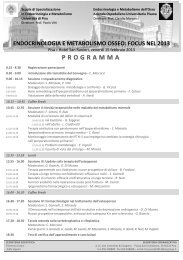Create successful ePaper yourself
Turn your PDF publications into a flip-book with our unique Google optimized e-Paper software.
Francisco J. Gonzalez<br />
the power of the good (νῦν δὴ καταπέφευγεν ἡµῖν ἡ τοῦ ἀγαθοῦ δύναµις εἰς τὴν τοῦ καλλοῦ φύσιν,<br />
64e5-6). 26<br />
One might of course be tempted to identify Agathon with the mere appearance of the good<br />
while identifying Socrates with its reality, 27 just as one might be tempted to identify poetry with mere<br />
imitation and philosophy with an unmediated grasp of the truth. 28 There can be no doubt that<br />
Agathon’s speech shows him to be an imitator par excellence, as it literally depicts love in his own<br />
image. Furthermore, this is the characteristic of Agathon that is emphasized in his portrayal by<br />
Aristophanes in the Themsmophorizusae. There, in the context of explaining why he is dressed as a<br />
woman, Agathon argues that the poet must himself be beautiful in order to compose beautiful plays,<br />
since “one necessarily composes things like one’s nature [ὄµοια γὰρ ποιεῖν ὰνὰγκη τῂ φύσει]” (167).<br />
This is a principle both explicitly articulated in Agathon’s speech in the <strong>Symposium</strong> when he cites<br />
with approval the old saying that like is drawn to like (ὅµοιον ὁµοίῳ ἀεὶ πελάζει, 195b5) and put to<br />
work there, since both the beauty of the speech itself and the beauty it attributes to love are only<br />
reflections of Agathon’s own beauty. But if we return to Aristophanes’ play, Agathon there is made to<br />
express the view that imitation is not simply the result of being good or beautiful, but can itself be that<br />
by which we become good and beautiful. In claiming that the poet must become like his characters,<br />
Agathon explains that “mimêsis can provide us with the things we do not possess [ἃ δ᾽οὐ κεκτήµεθα,<br />
µίµησις ἤδη ταῦτα συνθηρεὐεται], 155-156). 29 It is thus possible that in imitating the beauty and<br />
goodness of love Agathon seeks not only to reflect what he takes to be his own nature, but also further<br />
to become himself good and beautiful. Here it is worth noting that Socrates describes the young<br />
Agathon in the Protagoras as being not only beautiful in appearance, but as having a beautiful and<br />
good nature (καλόν τε κἀγαθον τήν φύσιν, τῆν δ᾽οὖν ἰδέαν πάνυ καλός, 315d). Furthermore, it would<br />
be wrong to identify Agathon with the poetic tradition Plato otherwise criticizes. For one thing, as we<br />
have already noted, Agathon, unlike the other speakers, treats his poetic sources critically. 30 This<br />
should not surprise us since Agathon’s distinction as a tragedian was to invent his own plots rather<br />
than imitate the traditional stories told by the poets. 31 And Agathon’s theatre, from what we know of<br />
it, could be judged to be especially philosophical in character. 32<br />
26 Commenting on the distinction between beauty and the good in Agathon’s speech, Ficino concludes: “bonitatis florem<br />
quemdam esse pulchritudinem volumus” (V.1.40). But for Ficino there are two senses to this analogy: beauty is the flower of<br />
the good not only in the sense that it is the outward manifestation of inner goodness, but also in the sense that, as the flower<br />
carries the seed from which other flowers will grow, beauty leads us to the good: “ut flores arborum seminibus orti semina<br />
ipsi quoque producunt, its spetiem hanc bonitatis florem, ut ex bono pululat, eic et ad bonum amantes producere” (V.1.40).<br />
27 Thus Allen, though showing the many ways in which Agathon’s speech anticipates Socrates’, concludes: “Both speeches<br />
are rhetorical. But Agathon’s rhetoric deals with appearance, as Socrates’ examination of it will show, and Diotima’s with<br />
reality” (R. E. Allen, translation and commentary, The Dialogues of Plato, Volume II: The <strong>Symposium</strong> [New Haven: Yale<br />
University Press, 1991], p. 40). Likewise, Sedley, while emphasizing the Socratic content of Agathon’s speech, in the end<br />
sees in Agathon nothing but “a pale ghost of the Platonic truth” and “mere ‘images’ of the philosophical understanding in<br />
which real virtue resides” (65). If Sedley acknowledges that of the speeches Agathon’s comes closest to the Platonic<br />
position, this ‘closest’ is still in his view immeasurably far. There can be no doubt that what Agathon provides is in some<br />
sense an image, but to assume that such an image is to be disparaged and rejected by the philosopher is to assume that the<br />
philosopher is capable of an unmediated access to the truth. Diotima of course describes such an ideal, but to believe that<br />
Socrates or any other philosopher could fully attain it, as Sedley apparently does (see p. 65), is to ignore the context of<br />
Diotima’s teaching and thus to misread the dialogue as a whole. For my own reading of the dialogue on this point, see “Il<br />
bello nel Simposio: sogno o visione?”, Méthexis XXV (2012): 51-70.<br />
28 “Agathon as sophist is an image of Socrates the philosopher and his imitation of mind as wisdom finds its original in<br />
Socrates’ knowledge of ignorance. Agathon, however, is a sophist who makes the unique claim that Eros is the core of his<br />
wisdom and its power. He is a peculiarly Socratic false image of Socrates whose sole expertise is erotics” (Berg, 89).<br />
29 Lèvêque sees here “une évolution dans la conception de l’artiste: il n’est plus le créateur d’une oeuvre qui exprime avec<br />
une nécessité intime sa nature profonde; il devient un acteur qui veut produire une impression et se prête, pour atteindre son<br />
but, à toutes les transformations de son être. A la place de la φύσις nait la τέχνη, ‘à la place de l’inspiration qui contraint, la<br />
rhétorique préméditée” (125).<br />
30 See Belfiore, 136.<br />
31 “Nevertheless even in tragedy there are some plays with but one or two known names in them, the rest being inventions;<br />
and there are some without a single known name, e. g. Agathon’s Antheus, in which both incidents and names are of the<br />
poet’s invention, and it is no less delightful on that account” (Aristotle, Poetics 6, 1451b19-24). Lèvêque argues that this was<br />
the play with which Agathon achieved the victory being celebrated in the <strong>Symposium</strong> (55). One piece of evidence he offers<br />
is the use of forms of the word for ‘flower’ (ἄνθος) at 196a8-b2, which can be plausibly taken as an allusion to the title of the<br />
tragedy (56; see also 111). Apart from its having an original plot, nothing is known about what this plot was; even the title<br />
Flower has been disputed (see Lèvêque, pp. 105-114). From the other titles that have been preserved, it is clear that Agathon<br />
most often was faithful to the old classical subjects. But he was also an innovator with regard to the musical dimension of<br />
tragedy and this in two respects: he reduced the choruses to mere intermezzi with no necessary connection to the plot and he<br />
introduced chromaticism, where “le chromatique permettait au poète d’exprimer toutes les nuances des sentiments et des<br />
passions” (151). As Lèvêque concludes, “C’est donc avant tout comme un novateur que se présente Agathon . . .” (153).<br />
32 As Lèvêque notes, “nous retrouvons dans la tragédie d’Agathon cette même attitude réflexive, ce même besoin de<br />
connaître l’homme et le monde, cette même curiosité inlassable de l’esprit, ce même effort d’analyse s’appliquant à la<br />
255




